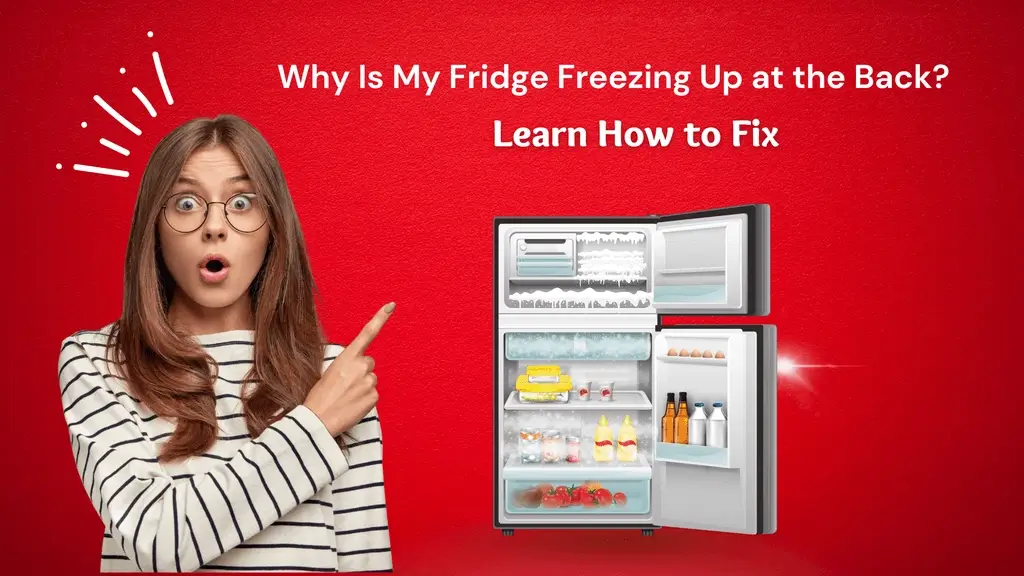Are you noticing why is my fridge freezing up at the back? We understand how frustrating it can be when your fridge starts freezing up at the back. Not only can it ruin your food, but it can also cause your energy bills to skyrocket. It’s a common issue that many people face, but not everyone knows why it happens.
In short, a fridge may freeze at the back for various reasons, including a faulty defrost timer, clogged air vents, or a malfunctioning thermostat. Each of these issues can cause a buildup of frost and ice on the back wall of your fridge, leading to poor cooling and potential damage to your food.
We’ve compiled this comprehensive guide to help you fix your fridge freezing up at the back and prevent it from happening again. We’ll go through each possible cause of the issue in detail, explain how to diagnose the problem and provide you with actionable solutions to get your fridge back in working order. By the end of this article, you’ll clearly understand what’s causing your fridge to freeze up at the back and how to fix it. So, let’s dive in!
Table Of Contents

Why Is My Fridge Freezing Up at the Back? Common Causes
Before we dive into the solutions, let’s look at some common causes of a fridge freezing up at the back. By understanding what’s causing the issue, you’ll be better equipped to prevent it from happening in the future.
Poor Airflow: One of the most common causes of a fridge freezing up at the back is poor airflow. When the airflow is restricted, the cold air doesn’t circulate properly, which can cause ice buildup at the back of the fridge.
Faulty Thermostat: A faulty thermostat can also cause a refrigerator to freeze up at the back. The thermostat controls the temperature inside the fridge. If it is not functioning correctly, it can cause the refrigerator to overcool and freeze up. Similarly, a faulty defrost timer can also cause the refrigerator to freeze up.
Faulty Defrost Heater: The defrost heater is responsible for melting any ice that may have formed on the evaporator coil. If the defrost heater is not working correctly, it can cause the refrigerator to freeze up.
Refrigerant Leak: A refrigerant leak can also cause a refrigerator to freeze up at the back. A refrigerant leak can decrease refrigerant levels, which can cause the fridge to overcool and freeze up.
Blocked Evaporator Coil: The evaporator coil is another possible cause of a refrigerator freezing up at the back. The evaporator coil is responsible for absorbing heat from the fridge and releasing it outside. If the evaporator coil is blocked with ice or dirt, it can cause the refrigerator to freeze up.
Dirty Condenser Coil: The condenser coil removes heat from the refrigerator and releases it into the air. If the condenser coil is dirty or covered with dust, it can cause the fridge to freeze up.
Damaged Door Seals: A damaged door seal can also cause your fridge to freeze up. When the seal isn’t tight enough, cold air can escape, and warm air can enter. This causes an imbalance in temperature, leading to freezing and ice buildup.
How to Fix a Fridge Freezing Up at the Back? Easy Solutions
Now that you understand the root causes of a fridge freezing up, here are some easy solutions to fix the problem:
Check the Thermostat: The first step in fixing a fridge that is freezing up at the back is to check the thermostat. Set the thermostat to a warmer temperature and see if that resolves the issue. If not, you may need to replace the thermostat.
Adjust the Temperature Control: If your fridge has a temperature control knob, adjust it to a warmer setting. This can help regulate the temperature and prevent freezing.
Inspect the Air Vent: Inspect the air vent at the back of the fridge to ensure it’s not blocked or dirty. If it is, clean it out to allow for proper airflow.
Move the Food Around: If the fridge is overpacked with food or drinks, it can restrict airflow and cause freezing. Try rearranging the items in the fridge to allow for proper airflow.
Defrost the Fridge: If the ice buildup is already significant, it’s time to defrost your fridge. First, turn off your fridge and remove all the food. Let the ice melt naturally, or use a hairdryer to speed up the process. Once the ice has melted, wipe the fridge’s interior and turn it back on.
Clean the Coils: The coils at the back of the fridge can accumulate dust and dirt over time, leading to restricted airflow and freezing. Clean the coils regularly to ensure proper functioning.
Inspect the Door Seal: A damaged or worn door seal can cause cold air to escape, leading to the fridge overworking and freezing up. Inspect the door seal and replace it if necessary.
Check the Fan: A malfunctioning fan can cause freezing at the back of the fridge. Inspect the fan and replace it if necessary.
Preventing a Fridge Freezing Up at Back
Now that we’ve covered the causes and fixes, let’s move on to how to prevent your fridge from freezing up.

Optimal Temperature Setting: The first step is to check your temperature setting. Your fridge should be set to a temperature between 37°F and 40°F (2.7°C and 4.4°C), and your freezer should be set to 0°F (-18°C). If your temperature is lower than this, adjust it accordingly. You may follow the instructions manual included with your fridge to set the optimal temperature.
Keep Your Vents Clear: Another way to prevent freezing is to keep your vents clear. Ensure there is enough space around your fridge and freezer for proper airflow. Don’t store items on top of or in front of the vents; make sure they’re not blocked by ice or frost.
Inspect Your Door Seal: A malfunctioning door seal can be a major cause of freezing. Check your door seal regularly to make sure it’s tight and secure. If you notice any cracks or gaps, you may need to replace the seal to prevent air leaks.
Defrost Your Fridge Regularly: Regular defrosting is important in preventing your fridge from freezing up. When you notice a buildup of ice or frost, it’s time to defrost your fridge. Unplug the fridge and remove all items from the freezer and fridge. Allow the ice to melt naturally, and then wipe down the inside of your fridge with a towel.
Use an Appliance Thermometer: To ensure that your fridge and freezer are at the correct temperatures, use an appliance thermometer. This will help you monitor the temperature and make adjustments if necessary.
Conclusion
A fridge that is freezing up at the back can be a frustrating experience, but it is a common problem that can be fixed. The cause may be a buildup of ice on the evaporator coil, a faulty defrost thermostat, or a malfunctioning defrost timer. Regular maintenance and cleaning can help prevent these issues from occurring. However, if you experience them, it is important to address them promptly to avoid further damage to your appliance. Following the tips and solutions outlined in this article, you can keep your fridge functioning correctly and avoid the inconvenience of a fridge that freezes up at the back.
